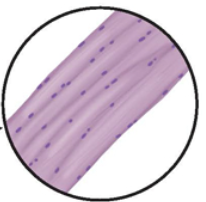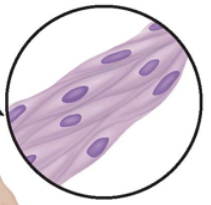Chapter 6 - The Human Body
1/24
There's no tags or description
Looks like no tags are added yet.
Name | Mastery | Learn | Test | Matching | Spaced |
|---|
No study sessions yet.
25 Terms
Cells
Foundation of human body
Tissues
Cells that share a common function
Organs
Groups of tissues that perform similar or interrelated jobs
Hinge Joint
Motion restricted to flexion and extension
Ball-and-socket Joint
Allows rotation and bending
Skull
Cranium = 4 bones
Face = 14 bones
Spinal Column
33 bones (vertebrae) in 5 sections:
Cervical
Thoracic
Lumbar
Sacrum
Coccyx
Thorax
12 thoracic vertebrae & 12 pairs of ribs
Thoracic cavity contains:
Heart
Lungs
Esophagus
Great vessels
Shoulder Girdle
3 bones come together:
Clavicle
Scapula
Humerus
Arm
Humerus = supporting bone
Ulna = pinky side
Radius = other side
Pelvic Girdle
Each pelvic bone is formed by fusion of ilium, ischium & pubis
Consists of:
2 coxae (hip bones)
Sacrum
Coccyx
Wrist & Hand
Ball-and-socket joint
Principle bones:
Carpals
Metacarpals
Phalanges
Upper Leg
Femur & Patella
Lower Leg
Tibia, Fibula, Ankle & Foot
Skeletal (Voluntary) Muscle
Striated

Smooth Muscle

Cardiac Muscle

Breathing
Ventilation AND respiration
Alveoli
Where the actual oxygenation happens
Upper Airway
Nose, Mouth, Tongue, Jaw (mandible), Pharynx (oral, nasal & laryngeal) & Epiglottis
Larynx (voice box) separates upper & lower airways
Lower Airway
Thyroid Cartilage (Adam’s apple), Cricothyroid Membrane, Cricoid Cartilage, Trachea, Carina & Left/Right Primary Bronchi
Lungs
Held in place by trachea, arteries, veins & pulmonary ligaments
Divided into 2 lobes — right & left
Right has 3 lobes
Left has 2 lobes (bc of heart)
Inside Lungs
Bronchi, bronchioles & alveoli
For gas exchange
Pleura
Layer of smooth, glistening tissue that covers each lung & lines the chest cavity
Visceral touches the lungs
Parietal touches cavity